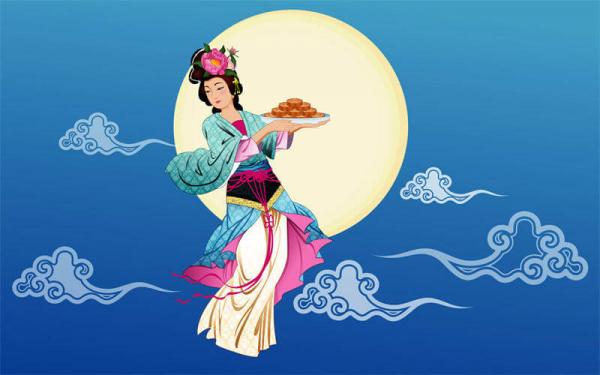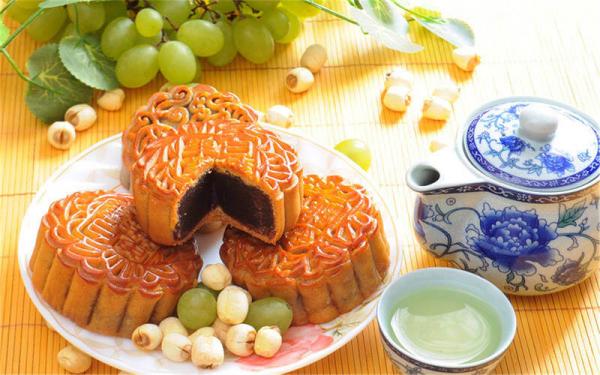Chinese Moon Cake - the Most Popular Mid-Autumn Festival Food
What is a Chinese Moon Cake?
Chinese mooncakes are not just confections; they're time-honored treasures that embody the spirit of the Mid-Autumn Festival.
Mooncakes were originally used as offerings to worship the moon god. Moon worship is a very ancient custom in China, which is actually a kind of worship activity of the ancient people to the "moon god".
Eating mooncakes and enjoying the moon on the Mid-Autumn Festival is an indispensable custom of the Mid-Autumn Festival in both the northern and southern parts of China. For generations, Chinese people treat them as festive food, and giving them to friends and relatives.
These round, palm-sized pastries have beautiful, nature- and prosperity-themed motifs on their golden-brown crusts. The fillings tucked inside are a variety of flavors that surprise and please the palate, so it's not simply the outside that draws the eye.

Chinese Mooncakes: Known by Many Names
While the name "Chinese mooncake" is widely recognized, it's interesting to note that these treats go by different names across various regions. In Cantonese, they are known as "mei zung" (Cantonese: 月餅), while in Mandarin, they're referred to as "yuè bǐng" (Mandarin: 月饼). This diversity reflects the richness of culture within China.
What is the Tradition and Story of Chinese Mooncake?
Chinese mooncakes have been a part of Chinese culture for more than a thousand years and are a representation of kinship and cultural legacy. Families gather to view the mid-autumn full moon in the night sky while enjoying these delicious sweets. This custom emphasizes the value of community by recalling the desire to remain connected despite physical distance.
So what is the story behind mooncake festival? Many are wondering.
The legend surrounding the Mid-Autumn Festival and its well-known mooncake dates back to ancient China. This event is weaved around the legend of Houyi, the valiant archer who destroyed nine out of ten suns, and his wife Chang'e, who drank the elixir of immortality. Exiled to the moon, Chang'e evolved into the Moon Goddess. People celebrate the moon's fullness on the 15th day of the eighth lunar month by eating on mooncakes and taking in the beauty of the celestial body.

When is Mooncake Season
Mooncakes usually come onto the market 1-2 months before the Mid-Autumn Festival in China. So, from late August to late September (in the Gregorian calendar), you can buy and taste mooncakes in supermarkets, markets, bakeries, and online. The peak sales period is about 1-2 weeks before the 15th day of the eighth lunar month (approximately late September and early October in the Gregorian calendar).
So, do you want to have mooncakes now?
What does Chinese Moon Cake Taste Like? Different Flavors
Chinese mooncakes are known for their diverse range of flavors. They have a variety of sweet and savory fillings available. The classic lotus seed paste filling has a sweet and nutty taste. In contrast, the flavors of salted egg yolk, black sesame, and red bean paste offer a variety of tastes to suit any palate.
Lotus seed paste, a traditional filling for Chinese moon cake, is made from dried lotus seeds that are boiled until they can be mashed into a paste. The paste is then sweetened with sugar, and sometimes flavored with rose petals, almonds, or sesame seeds. This filling has a sweet and nutty taste, with a smooth and creamy texture.
Red bean paste, another popular filling, is made from boiled and mashed adzuki beans. The paste is then sweetened with sugar and sometimes flavored with vanilla or pandan leaves. This filling has a sweet and earthy taste, with a slightly grainy texture.
Black sesame paste is made from toasted black sesame seeds that are ground into a paste. The paste is then sweetened with sugar and sometimes flavored with honey. This filling has a nutty and slightly bitter taste, with a gritty texture.
Savory mooncakes frequently contain a filling of salted egg yolk. The egg yolk is wrapped with lotus seed paste or other fillings after being first cured in a salt and spice mixture. This filling has a distinct, rich flavor and a salty, savory flavor.

How to Enjoy Mooncakes during Mid-Autumn Festival
Here are some tips to enhance your mooncake-eating experience:
Unwrapping: Gently unwrap the mooncake from its packaging, taking care not to damage the delicate exterior. Some packaging may have special designs or decorations that add to the festive atmosphere.
Appreciation of the visual arts: Look at the mooncake's surface to see the elaborate pattern. Numerous mooncakes have lovely designs or representations, such as Chinese characters, flowers, or animals. Your appreciation of the mooncake can be increased if you recognize its aesthetic artistry.
Slicing: Cut the mooncake into more manageable pieces using a knife. This might make eating more enjoyable and enable you to appreciate the various contents and flavors. The mooncake can also be shared with others because it is frequently viewed as a representation of harmony and togetherness.
Savoring: Take small bites and relish the combination of flavors and textures. Mooncakes often have a delicate, crumbly pastry shell that contrasts with the rich and sweet filling. Chewing slowly and allowing the flavors to mix in your mouth can heighten your appreciation of the pastry.
Enjoy mooncake with tea: To counteract the sweetness and improve the experience, pair mooncakes with Chinese tea. Tea's scent and bitterness can assist balance the richness of the mooncake and help you clear your palate in between bites. It's common to drink green tea, oolong tea, or pu-erh tea with mooncakes.

Do You Eat Chinese mooncakes cold or hot?
Chinese mooncakes are often consumed at room temperature or after being slightly warmed. In order to fully appreciate the flavors and textures of mooncakes, its fillings and crust should be eaten at a moderate temperature. Although some could want to microwave or bake them, it's more typical to eat mooncakes at a pleasant room temperature.How many mooncakes should I eat?
Your personal choice, the size of the mooncake, and the filling will all influence how much Chinese mooncake you should consume. There is no set amount that must be consumed when eating moon cakes because there are a variety of shapes and fillings. Mooncakes are typically fairly rich and dense, thus they can be rather full.
Sharing mooncakes with family and friends involves slicing them into multiple smaller servings. Everyone is able to savor the tastes without getting too full as a result. If you've never tried mooncake before, start with a smaller piece to see how you enjoy it before deciding on your serving size.
Gifting Mooncakes during Mid Autumn Fesetival: A Gesture of Gratitude
The Mid-Autumn Festival is a time when people come together to celebrate the harvest and the full moon. It is a time for families to gather and share food, stories, and laughter. One of the most important Mid-autumn Festival traditions is the gifting of Chinese mooncakes.
The act of gifting mooncakes during the Mid-Autumn Festival carries profound meaning. It is not merely a gesture of kindness, but a symbol of gratitude and respect. By sharing mooncakes with loved ones, friends, and business associates, people are expressing their appreciation for the bonds that they share and the warmth of their relationships. It is also a way of showing one's generosity and hospitality.
For the Mid Autumn Festival this year, why not crafting Chinese mooncakes at your own kitchen?!

Chinese Mooncake Recipe with Popular Fillings
Chinese mooncakes are a type of art that requires talent and accuracy. Making the fillings is the first step in the procedure. Popular fillings for these desserts include salted egg yolks, red bean paste, and lotus seed paste.
The perfect texture of the dough is meticulously designed to complement the sweet filling. Exquisite designs are frequently imprinted on the surface using complex molds.
These pastries are prepared to adorn tables and palates once they have baked to a golden color.Today we’re going to show you how to make Chinese mooncake with lotus seed paste filling.
Ingredients:
Instructions:
- In a bowl, combine alkaline water, vegetable oil, and golden syrup.
- Gradually add flour and knead into a dough.
- Equal portions of the dough and filling should be made.
- Wrap filling with dough and shape into mooncake molds.
- Egg wash the mooncakes and preheat the oven.
- Bake until golden and shiny.
- Your moon cake is ready to serve!